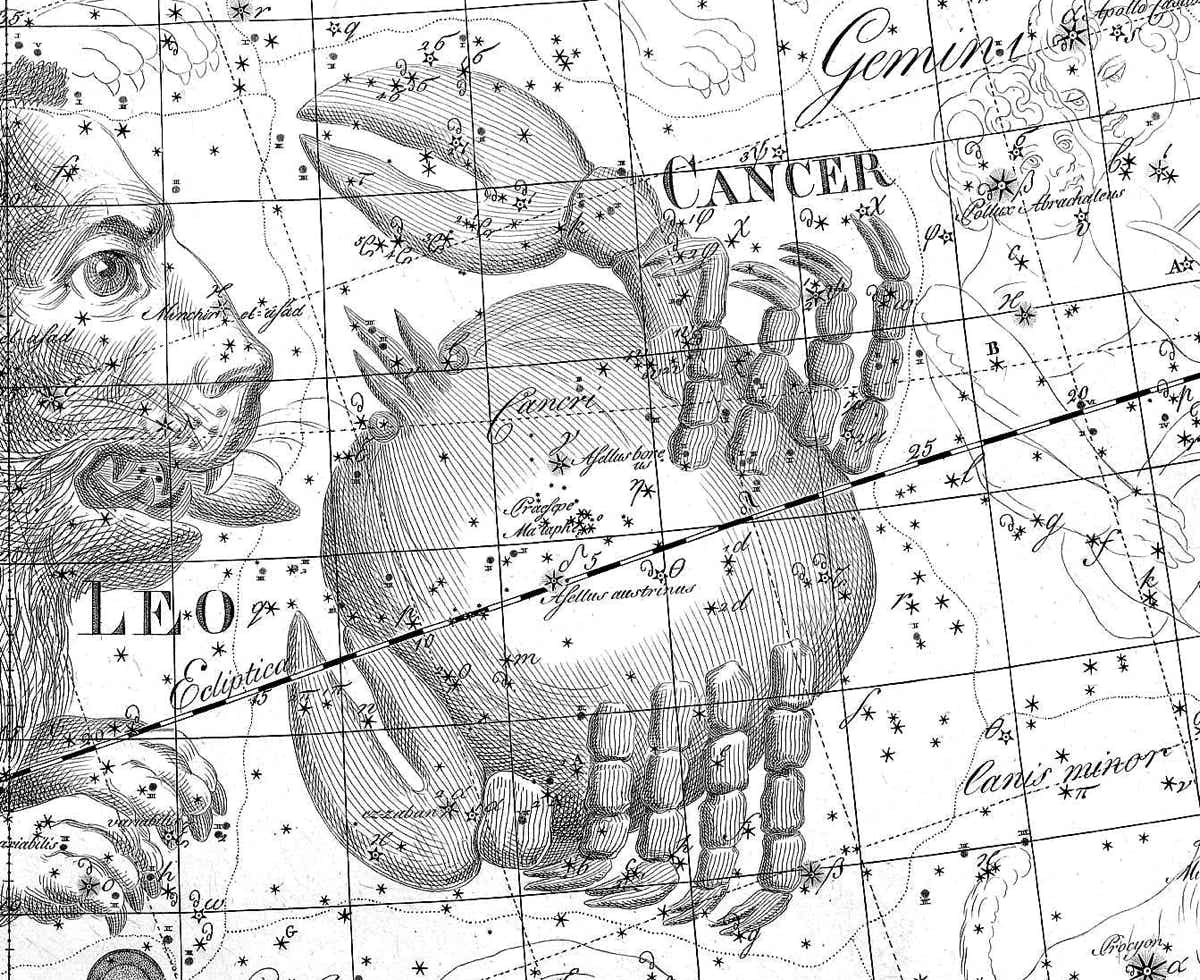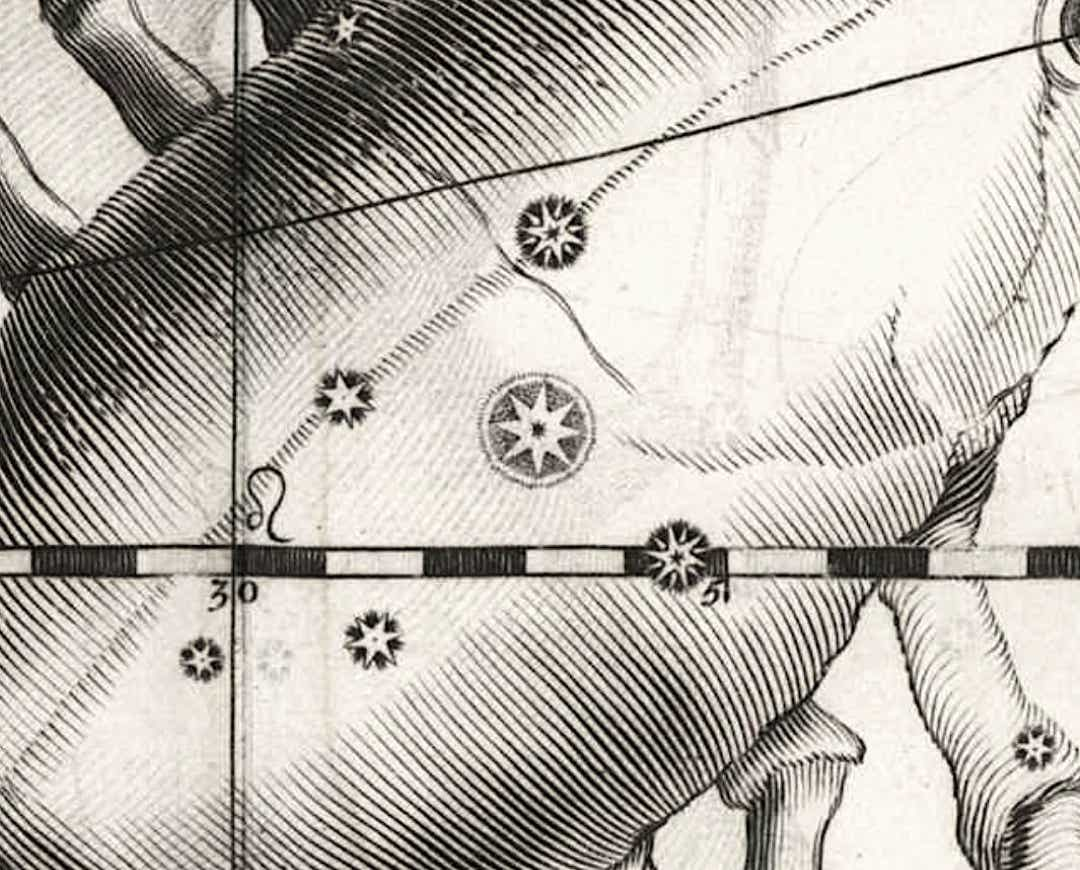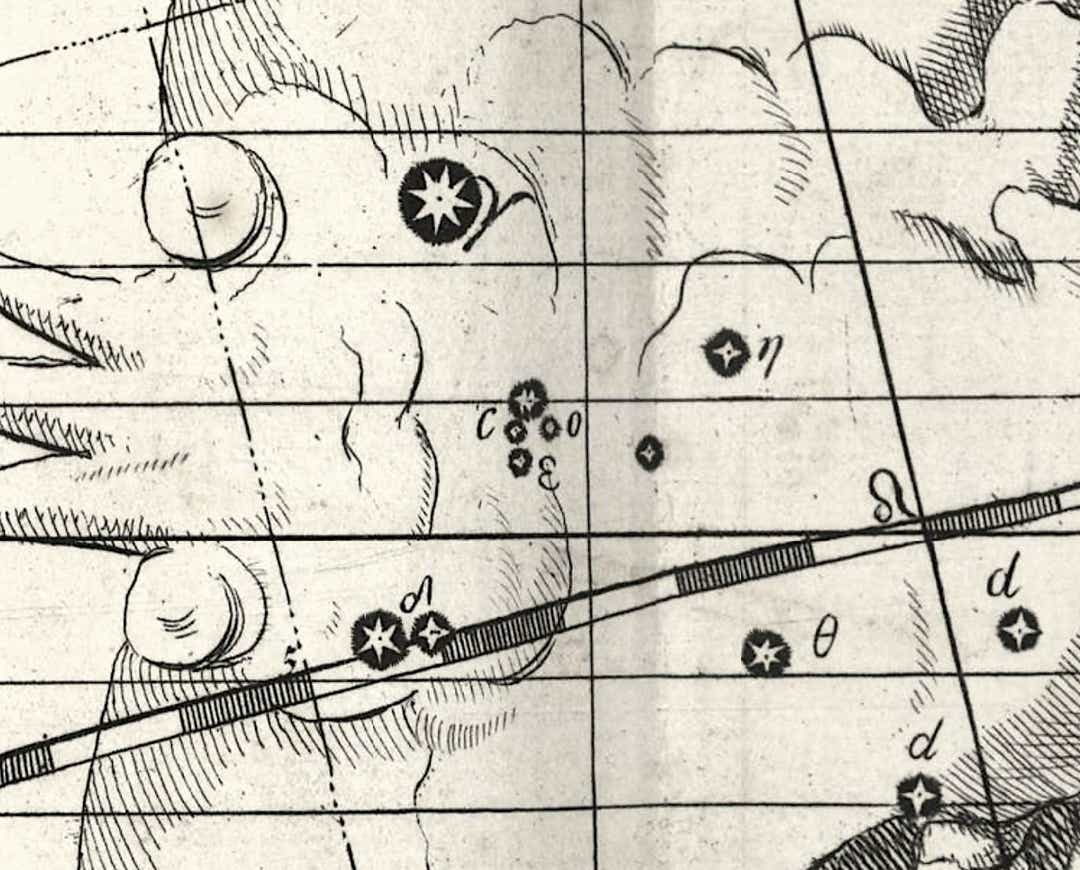
Genitive: Cancri
Abbreviation: Cnc
Size ranking: 31st
Origin: One of the 48 Greek constellations listed by Ptolemy in the Almagest
Greek name: Καρκίνος (Karkinos)
The crab is a minor character in one of the labours of Heracles (the Greek name for Hercules). While Heracles was fighting the multi-headed monster called the Hydra in the swamp near Lerna, the crab emerged from the swamp and added its own attack by biting Heracles on the foot. Heracles angrily stamped on the crab, crushing it. For this modest contribution to history, we are told that the goddess Hera, the enemy of Heracles, put the crab among the stars of the zodiac. Its name in Greek was Καρκίνος (Karkinos), or Carcinus in Latin transliteration.
Fittingly enough for such a minor character it is the faintest of the zodiacal constellations, with only six stars brighter than magnitude 5.0. The star Alpha Cancri is named Acubens, from the Arabic al-zubānā meaning ‘claw’. As Ptolemy described it in the Almagest, this star lies on the southern claw of the crab; the northern claw is marked by Iota Cancri. Beta and Mu Cancri lie on the southern and northern rear legs, respectively.
Cancer, from Chart XIII of Johann Bode’s Uranographia (1801). At its centre lies the star cluster Praesepe, flanked to the north and south by the stars Asellus Borealis and Asellus Australis (Gamma and Delta Cancri). On this chart the cluster is given the alternative name Ma’laph, from the Arabic al-mi’laf, meaning crib or manger. Bode’s name for Alpha Cancri, ez-zaban, comes from the Arabic al-zubānā meaning ‘claw’, the same root as the modern name Acubens. Some charts showed Cancer looking like a lobster rather than a crab, notably that of Johannes Hevelius.
The asses and the Manger
Gamma and Delta Cancri, magnitudes 4.7 and 3.9, were known jointly to the Greeks as Ὄνοι (Onoi), the asses; we know them by their individual Latin names Asellus Borealis and Asellus Australis, the northern ass and southern ass, and they have their own legend. According to Eratosthenes, during the battle between the gods and the Giants that followed the overthrow of the Titans, the gods Dionysus, Hephaestus, and some companions came riding on donkeys to join the fray. The Giants had never heard the braying of donkeys before and took flight at the noise, thinking that some dreadful monster was about to be unleashed upon them. Dionysus put the asses in the sky, either side of a hazy-looking patch which the Greeks called Φάτνη (Phatne), the Manger, from which the asses seem to be feeding.
Ptolemy in the Almagest described Phatne as ‘the nebulous mass in the chest’ without knowing what it actually was. Its true nature as a cluster of faint stars was not established until 1609 when Galileo first turned a telescope on it. Astronomers now know this star cluster by its Latin name Praesepe, but it is popularly termed the Beehive – praesepe can mean both ‘manger’ and ‘hive’. It is also known as M44 from its number in Charles Messier’s catalogue of nebulous objects. In Arabic it was called al-Mi’laf, meaning crib or manger, the same meaning as in Greek and Latin.
Johann Bayer showed Praesepe as a nebulous star on his Uranometria atlas of 1603 (compiled before the invention of the telescope), and labelled it Epsilon; this letter is now applied specifically to the brightest member of the cluster, of magnitude 6.3. Johannes Hevelius also depicted the cluster as a nebulous star on his Firmamentum Sobiescianum of 1690, but did not label it. John Flamsteed, who observed telescopically, showed it as a small cluster of four stars on his Atlas Coelestis of 1729. Bode's representation of 1801, above, added some fainter stars.
Tropic of Cancer
The tropic of Cancer is the latitude on Earth at which the Sun appears overhead at noon on the summer solstice, June 21. In the time of the ancient Greeks the Sun lay among the stars of Cancer on this date, but the wobble of the Earth on its axis called precession has since moved the summer solstice from Cancer through neighbouring Gemini and into Taurus.
Chinese associations
In China the four stars surrounding the open cluster Praesepe (Delta, Gamma, Eta, and Theta Cancri) were known as Gui, literally ‘Ghosts’, referring to the spirits of the deceased. The 23rd Chinese lunar mansion was named Gui after this asterism. Praesepe itself was called Jishi, a group of corpses. Praesepe and its four surrounding stars were sometimes seen as a ghost being carried in a sedan chair; hence this quadrilateral was also given the alternative name Yugui, Ghost Wagon.
To the north of Gui was another quadrilateral of stars forming a figure called Guan, a beacon fire on a watchtower; however, sources differ as to which four stars were involved and indeed the Chinese themselves probably used different stars at different times. The usual version places Guan in the area around Chi Cancri while another favours the region of Iota Cancri. A chain of four stars that crossed into Cancer from Canis Minor was Shuiwei, ‘water level’.
© Ian Ridpath. All rights reserved
Praesepe was shown by Johann Bayer as a hazy star at the centre of the body of Cancer, the crab, on his atlas Uranometria (1603). He labelled it Epsilon (ε). This was still the pre-telescopic era, so Bayer was not aware that it was actually a cluster of faint stars. The stars labelled Gamma and Delta on his chart, above and below left of Praesepe, are jointly known as the Asses. The horizontal striped band is the ecliptic.
Like Bayer before him, Johannes Hevelius showed Praesepe as a nebulous star on his atlas Firmamentum Sobiescianum of 1690, but he did not use Bayer’s identifying letters. Hevelius drew his constellations as seen on a globe, so the image is reversed from left to right by comparison with the sky. The horizontal striped band is the ecliptic.
John Flamsteed’s depiction of Praesepe in his Atlas Coelestis (1729), compiled with the aid of a telescope, shows it as a cluster of four stars. On this chart the ecliptic runs diagonally and lines of declination are horizontal. Note the change in coordinates of the stars due to precession since Bayer’s time.






